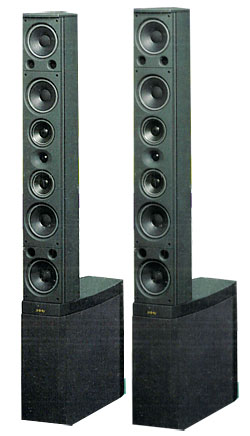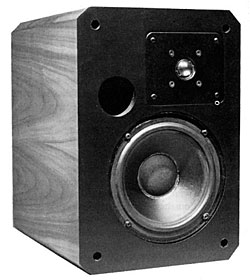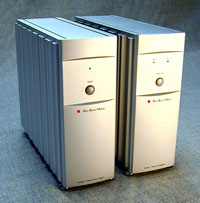Yet Another Show: TAVES Starts Friday in Toronto
"I'm pretty excited about the preponderance of manufacturers, because they tend to have more elaborate set-ups and bring a lot more product with them," Kajko told Stereophile.
"I'm pretty excited about the preponderance of manufacturers, because they tend to have more elaborate set-ups and bring a lot more product with them," Kajko told Stereophile.
 I can't think of two products at further ends of the audio spectrum than a single-ended triode tubed amplifier and a mass-market Home Theater loudspeaker. Single-ended tubed amplifiers are about reproducing subtlety, delicacy, nuance, and communicating the music's inner essence. Conversely, a Home Theater loudspeaker systemparticularly one made by a mass-market manufacturerwould appear to put the emphasis on booming bass and reproducing shotgun blasts, with little regard for musical refinement.
I can't think of two products at further ends of the audio spectrum than a single-ended triode tubed amplifier and a mass-market Home Theater loudspeaker. Single-ended tubed amplifiers are about reproducing subtlety, delicacy, nuance, and communicating the music's inner essence. Conversely, a Home Theater loudspeaker systemparticularly one made by a mass-market manufacturerwould appear to put the emphasis on booming bass and reproducing shotgun blasts, with little regard for musical refinement.
What a bizarre marriage it was, then, to pair the new Infinity Composition Prelude P-FR loudspeakers with the Cary Audio Design CAD-300SEI 11W single-ended triode amplifier (reviewed elsewhere in this issue). This combination didn't happen by accident; as you'll see, these apparently disparate products are a match made in heaven.
I discovered the Infinity Preludes while surveying Home Theater loudspeaker systems for the upcoming second issue of the Stereophile Guide to Home Theater. In addition to evaluating the loudspeaker systems under review with video soundtracks, I assessed their musical qualitiesor lack thereof. The Preludes were such a musical standout that I rescued them from the Home Theater room (where they had been powered by mass-market receivers and fed with a laserdisc source) and gave them a new lease on life in the larger music room, with reference-quality source and amplification components. The Preludes' extraordinary musical performance and unique design compelled me to tell you about how they performed in an audiophile-quality two-channel playback system.
For many people, the Internet means access to email, social networking sites, weblogs, forums, countless apps and other crap. For me, the Internet will inevitably mean Computer Audio.
And when the time comes for me to dive into Computer Audio, I’ll rely on Michael Lavorgna’s AudioStream to lead the way.
After an exhausting but educational day at NYC’s In Living Stereo setting up my new Rega RB101 tonearm with the Audio Technica AT95E phono cartridge, I hailed a taxi while balancing the turntable on one hand. Thirty minutes later, the yellow cab stopped at the doorstep of my quaint Brooklyn duplex, which I share with three other roommates, a Chartreux cat named Larry, and three friendly Pakistani families.
Upon my return home with the P1, the roommates were ecstatic. Jared analyzed, “I dig its minimalist design.” Leeor cheered, “I can’t wait to play the new Animal Collective record on this!” Darryl insisted, “Yo, you need to bring some bitties back now.” Larry the Cat ignored our excitement and cuddled with my phono preamp’s glowing tube. After listening to some records together, I kicked the roommates out for some alone time with my system. No bitties yet, but I did have a mug of green tea, some LPs, and Larry.
 While it is not quite accurate to say that $500/pair loudspeakers are a dime a dozen, they are by no means unusual. And since this is a price area where major design compromises are mandatory (footnote 1), the sound of such loudspeakers tends to vary all over the map, from pretty good to godawfuldepending on what performance areas the designer chose to compromise and by how much.
While it is not quite accurate to say that $500/pair loudspeakers are a dime a dozen, they are by no means unusual. And since this is a price area where major design compromises are mandatory (footnote 1), the sound of such loudspeakers tends to vary all over the map, from pretty good to godawfuldepending on what performance areas the designer chose to compromise and by how much.
I approached this latest half-grander with little enthusiasm, despite Siefert's persuasive literature, I have, after all, been reading such self-congratulatory hype abiout new products for longer than most Stereophile readers have been counting birthdays. This, I must admit, was ho-humsville.
 Mark Levinson, born December 11, 1946, celebrates an important anniversary in 2002. Exactly 30 years ago he jogged onto the playing field of high-end audio, so early in the game that fans, then few and far between, could count the players on their fingers.
Mark Levinson, born December 11, 1946, celebrates an important anniversary in 2002. Exactly 30 years ago he jogged onto the playing field of high-end audio, so early in the game that fans, then few and far between, could count the players on their fingers.
The high-fidelity industry seems a logical home for a jazz musician like Levinson, who once envisioned a career playing flugelhorn and double bass, but his voyage into audio was a detour that could be said to have begun at age 22, when he took a job working on a film about Joan Baez. "It was a joy to find people willing to pay me to do something," quips the trim, youthful 55-year-old, who is quick to recall his "nonexistent income as a musician."